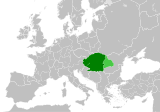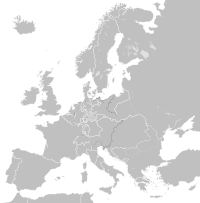User:Alphathon/Historical Europe
Jump to navigation
Jump to search
English: This map is part of a series of historical political maps of Europe. All maps by Alphathon and based upon Blank map of Europe.svg unless otherwise stated.
Deutsch: Diese Karte ist Teil einer Serie historischer politischer Europakarten. Solange nicht anders angegeben, wurden alle Karten durch Alphathon auf Basis von Blank map of Europe.svg erstellt, sofern nicht anders angegeben.
Français : Cette carte fait partie d'une série de cartes historiques et politiques d'Europe. Toutes les cartes ont été créées par Alphathon et basées sur Blank map of Europe.svg sauf indication contraire.
Evolution of specific states
Greece/Byzantine Empire
| Byzantine Empire: ca. 330 – 1204; 1261 – 1453 | |||||||||
| Although usually referred to as the Byzantine or East(ern) Roman Empire today, or even as Byzantium, the empire's official name was Imperium Romanum /Βασιλεία Ῥωμαίων : Roman Empire. | |||||||||
 |
 |
||||||||
| Byzantine Empire – 814 | Byzantine Empire – 1190 | ||||||||
| 1453 – 1832 Between 1453 and 1832 there was no independent Greek state. During this period the region was ruled by the Byzantine Empire's Turkish successor: the Ottoman Empire. | |||||||||
| Greece: 1832 – Today | |||||||||
 |
 |
 |
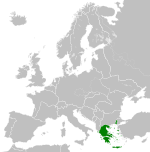 |
 |
|||||
| Kingdom of Greece – 1890 | Kingdom of Greece – 1914 | Second Hellenic Republic – 1935 | Hellenic State – 1942 | Kingdom of Greece – 1973 | |||||
France
 |
 |
 |
 |
 |
|
| Frankish Empire – 814 | West Francia – 843 | Kingdom of France – 1000 | Kingdom of France – 1097 | Kingdom of France – 1190 | |
| Also known as Francia, the Kingdom of the Franks and the Carolingian Empire | Partitioned from Francia in the Treaty of Verdun along with Middle Francia and East Francia (later the Kingdom of Germany; see below) | ||||
 |
 |
 |
 |
 |
|
| Kingdom of France – 1789 | First French Empire – 1812 | Kingdom of France – 1815 | Kingdom of France – 1839 | French Third Republic – 1914 | |
 |
 |
 |
 |
||
| French Third Republic – 1939 | French State (Vichy France) – 1942 | Provisional Government of the French Republic – 1945-1949 | French Fourth Republic – 1946-1957 | ||
| See also: French State (incl. occupation zone) – 1942, Military Administration in France – 1942, Military Administration in Belgium and Northern France – 1942 |
Germany/Holy Roman Empire
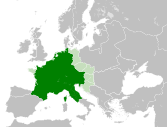 |
 |
 |
 |
 |
 |
 |
||||||||||||||
| Frankish Empire – 814 | East Francia – 843 | Holy Roman Empire – 1000 | Holy Roman Empire – 1004 | Holy Roman Empire – 1097 | Holy Roman Empire – 1190 | Holy Roman Empire – 1789 | ||||||||||||||
| Also known as Francia, the Kingdom of the Franks and the Carolingian Empire | Partitioned from Francia in the Treaty of Verdun along with Middle Francia and West Francia (later the Kingdom of France; see above) | See also: Kingdom of Germany – 1000 | See also: Kingdom of Germany – 1004 | |||||||||||||||||
| 1806 In 1806 the Holy Roman Empire was dissolved under French pressure. | ||||||||||||||||||||
 |
 |
 |
||||||||||||||||||
| Confederation of the Rhine – 1812 | German Confederation – 1815 | North German Confederation – 1870 | ||||||||||||||||||
| A confederation of German client-states of the First French Empire | An attempted partial resurrection of the Holy Roman Empire after the Napoleonic wars | A Prussian-dominated successor to the German Confederation following the 1866 Austro-Prussian War | ||||||||||||||||||
| 1871 In 1871 the Prussian-ruled North German Confederation was united with the southern German states (except Austria; the so-called Lesser German Solution) to form the German Empire, the first modern German state. | ||||||||||||||||||||
 |
 |
 |
 |
 |
 |
 |
||||||||||||||
| German Empire – 1914 | Weimar Republic – 1930 | German Reich – November 1938-March 1939 | German Reich – Mar-Sep 1939 | Greater German Reich – 1942 | Federal Republic of Germany (West Germany) – 1956-90 | German Democratic Republic (East Germany) – 1956-90 | ||||||||||||||
Austria
 |
 |
 |
 |
 |
 |
| Habsburg Monarchy – 1714 | Habsburg Monarchy – 1789 | Austrian Empire – 1812 | Austrian Empire – 1815 | Austria-Hungary – 1914 | Federal State of Austria – 1938 |
| See also: Austrian Empire excluding Lombardy-Venetia – 1815, Kingdom of Lombardy-Venetia – 1815 | These borders also applied to the First Austrian Republic (1919–34) |
Hungary
Italy
| Northern Italy | ||||||
| 774 – 12th century/1805 | ||||||
| In 774 Charlemagne conquered the Kingdom of the Lombards. However, only northern and central Italy fell under Frankish control (nominally including the central Italian Papal territory). This northern portion later evolved into the Kingdom of Italy (following its partition from Middle Francia in the 855 Treaty of Prüm), and formed part of the Holy Roman Empire from 962. Other than a few periods of personal union with its southern neighbours, the north-south divide would remain until the unification of Italy in the 19th century. | ||||||
 |
 |
 |
||||
| Frankish Empire – 814 | Middle Francia – 843 | Kingdom of Italy (Holy Roman Empire) – 1000 | ||||
| Also known as Francia, the Kingdom of the Franks and the Carolingian Empire | Partitioned from Francia in the Treaty of Verdun along with West Francia (later the Kingdom of France; see above) and East Francia (later the Kingdom of Germany; see above) | Constituent Kingdom of the Holy Roman Empire 951–1806 (although its states became autonomous in 1176 and for most practical purposes it ceased to exist far earlier than 1806) | ||||
| 1805 – 1814 | ||||||
| In 1805 Napoleon crowned himself King of Italy and subsequently created a client-kingdom in north-eastern Italy. | ||||||
 |
||||||
| Kingdom of Italy (Napoleonic) – 1812 | ||||||
| Client state of the First French Empire; existed 1805–1814 | ||||||
| Southern Italy | ||||||
| 774 – 1860 | ||||||
| While Charlemagne conquered the northern portion of the Lombard kingdom, the south remained separate, apart from a few periods of personal union, until the unification of Italy in the 19th century. As an single entity, southern Italy was sometimes united, sometimes not, during this period. | ||||||
 |
 |
 |
||||
| Norman possessions in southern Italy – 1097 | Norman Kingdom of Sicily – 1190 | Kingdom of the Two Sicilies – 1839 | ||||
| While not a united polity, the County of Sicily and Duchy of Apulia and Calabria were both ruled by members of the House of Hauteville (in 1097 by Roger Bosso (uncle) and Roger Borsa (nephew) respectively) and were closely tied. | ||||||
| Italian Unification | ||||||
| 1860 – Today | ||||||
| In 1860 the Kingdom of Sardinia united almost all Italian lands into the newly re-formed Kingdom of Italy, and within the next decade the remainder of Italian lands not part of the Austrian Empire/Austria-Hungary, Switzerland or San Marino were also integrated. | ||||||
 |
 |
 |
 |
 |
 |
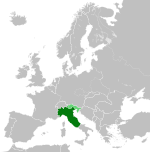 |
| Kingdom of Sardinia – 1860 | Kingdom of Italy – 1861 | Kingdom of Italy – 1870 | Kingdom of Italy – 1914 | Kingdom of Italy – 1936 | Kingdom of Italy – 1943 | Italian Social Republic – 1943 |
Poland
 |
 |
 |
 |
 |
|
| Duchy of Poland – 1000 | Kingdom of Poland – 1097 | Kingdom of Poland – 1190 | Polish-Lithuanian Commonwealth – 1714 | Polish-Lithuanian Commonwealth – 1789 | |
| Following the First Partition of Poland in 1772 | |||||
 |
 |
 |
 |
 |
|
| Duchy of Warsaw – 1812 | Congress Poland – 1815 | Second Polish Republic – 1930 | General Government – 1942 | Polish People's Republic – 1956-90 | |
| See also: Free City of Danzig – 1812 | Officially the Kingdom/Tsardom of Poland in a personal union with the Russian Empire. Incorporated in a real union in 1832. Fully integrated in 1867 as the Vistula Land |
See also: Free City of Danzig – 1930 |
Brandenburg, the Teutonic Order and Prussia
9th Century
814
11th Century
1000
1097
12th Century
1190
18th Century
1714
1789
1797
 |
19th Century
1812
| Europe at the height of Napoleon's power. | |
 |
|
1815
| Europe following the Congress of Vienna, which restored much of the old order following the Napoleonic wars. | |
 |
|
1839
 derivative work by ArnoldPlaton |
|
1890
 |
|
20th Century
1914
 |
|
1929-1938
 |
|
October 1938 - March 1939
 |
|
March - September 1939
 derivative work by Goran tek-en |
|
1942
1956-1990
 |
|

